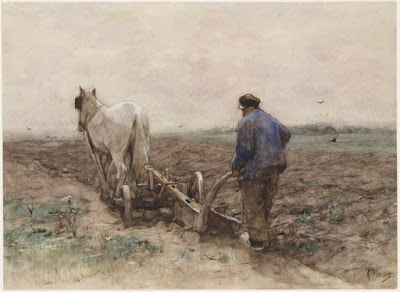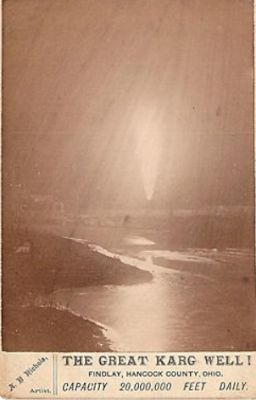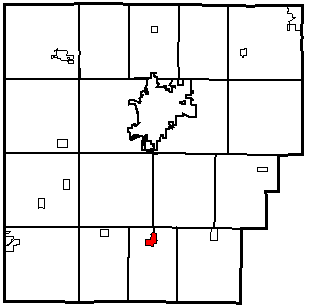 |
Johann Philip Schneider (aka Philip Snyder)
(1831-1909)
(given to me by R.M., my 1st cousin 1x removed - Thank you!)
Click to make bigger. |
Johann Philip Schneider was born 10 Jan 1831 in Hessen-Darmstadt Germany to Johann Jakob Schneider and Eva Maria Hauman. I’ll list his siblings in his parents’ entry, (which you can see
HERE).
I’m not certain whether he moved to the United States at the same time his father did or at a different point as part of his family's immigration to the United States. I do know that he had immigrated to the USA by 1856, because that’s the year he married Hannah Essinger, daughter of Adam Essinger and Anna Catharina Simmermacher (their story
HERE), on 11 September, in Hancock County Ohio. I also don’t know whether he was a naturalized citizen by the time he married. If he wasn’t, even though she was born in Pennsylvania in 1834, she would have lost her citizenship by marrying him because in the mid-1800s a woman’s citizenship was tied to that of her husband. She would retain her citizenship if he was a naturalized citizen when they married or regain it when he became a naturalized citizen.
Over the course of their marriage, Phillip and Hannah had nine children. Their eldest daughter Katherine M. was my 2nd great-grandmother (1857-1931); she married my second great-grandfather, John Snyder [his story
HERE]). Philip and Hannah’s other children were: Frederick Nicholas (1860-1936, m. Mary Ellen DuMond); George Snyder, (1862-1952, m. Elizabeth Hosafros); Elizabeth Snyder (1865-1955, m. William Patterson); Philip Snyder (10 February 1869-1898); John Harvey (1870-1952, m. Alice Bartchlett); Alexander W. (1873-1957, m. Sadie L. Hartman); Charles (1875-1957, m. Florence Fetters); and William H. (1878-1961, m. Rosetta F Brown). The family lived in a small village in Hancock County, Ohio, called Arlington, or in the surrounding Madison Township during the years in which the children were born.
After their marriage, at some point, the family anglicized their last name. Many immigrants did this to help them fit into their new country better. One of the most common ways to make a name sound more American was to simplify the pronunciation and spelling, and that seems to be what my family chose to do. Sometimes immigrants used an anglicized version of their name publically but used their original name within the family. (The idea that names were changed at the port of entry – the Schneiders got here over 30 years before Ellis Island opened – is a myth.)
In their 1860 Census, the last name is listed as Snider. Philip (age 29) and Hannah (age 26) and their first two children, Catherine (age 2) and Frederick Nicholas (listed as Nicholos, age 5/12), were living with Philip’s father Jacob (age 66), Philip’s older sister Elisabeth (age 33) and her daughter Mary (age 6), and Philip’s younger brother George (age 22) in Union Township, Hancock County, Ohio. The closest Post Office was Hassan, which no longer exists but the pin in the map in the next image will show you where it was, and thus give a general idea of where they were. The Census indicates that Jacob, Elisabeth, Philip, George, and Mary were born in Hesse, Germany; Hannah was born in Pennsylvania; and Catherine and Nicholos were born in Ohio. Jacob was working as a day laborer and Philip was a carpenter. All the adults (over 20) could read and write. Philip had real estate valued at $750 (as a comparison, in today’s money that would be $21, 127.98). He is not shown as having any personal property of any value.
In 1869, Philip Snyder (note the change from Snider to Snyder) served on a Hancock County Court of Common Pleas Grand Jury, commencing April 6, 1869.
In the 1870 Census the family name was Snyder as well.* They had moved to Madison Township in Hancock County, Ohio; the closest Post Office was in Arlington, a village in the south of Hancock County (see below), about ten miles from the county seat, Findlay. Philip (age 39) and Hannah (age 35) Snyder are living with six of their children: Catherine (12), Nicholas (9), George (8), Elizabeth (5), Philip (2), and John (6/12, born in February). Catherine, Nicholas, George, and Elizabeth attend school. Also living with them is Philip’s father Jacob (77) and Philip’s younger brother, George (32). Philip is now a millwright and a farmer; he has real property worth $2000 and personal property worth $681 (value today: $35,995. 82 in real property and $12,256.58 in personal property). The census shows that Jacob, and Philip and his brother George were born in Germany, and states that all the children and their mother were born in Ohio (erroneously as to Hannah). Jacob is listed as a retired farmer, and George as a farmer; but neither of them shows any real property or personal property owned so perhaps they work on the family farm on land owned by Philip.
According to the 1870 non-population census schedule for farms, Philip had 40 acres of improved land and 40 acres of woodland. He valued the farm at $3000 (today $50,993) and the farm implements and machinery at $150 ($2,549). As of June 1, 1870, the farm had 5 horses (this was before tractors), 4 milk cows, 4 other cattle (not mules, asses, and oxen), 17 sheep, and 8 pigs – total value $431 (today $7,326). During the year ending June 1, 1870, the farm produced 125 bushels of winter wheat, 100 bushels of Indian corn, 130 bushels of oats, 60 pounds of wool, 300 pounds of butter,8 tons of hay, 10 gallons of molasses, and $172 worth of meat (today $2,923). The estimated total value of all the farm produce in that year was $630 (today $10,708).
Philip’s father Jacob died in 1871, and his brother George died in 1872, only 35 years old. Both are buried in St. Paul’s Cemetery in Van Buren Township, Hancock County.
The 1880 Census is the first one where we find Philip’s family alone, without any other relatives living with them. Philip (age 49) and Hannah (age 46) were living in Madison Township, Hancock County with seven of their children: George (18), Elisabeth (14), Philip (12), John (11), Alexander (8), Charles (5) and William (2), Philip Sr is listed as a farmer and his wife Hannah as keeping house. Sons George, Philip, and John are shown as ‘working on the farm’. The census also indicates that Elisabeth, Philip Jr, John, and Alexander attended school during the year. It also indicates that the whole family can read and write. It lists both Philip sr and (erroneously) Hannah as having been born in Hesse-Darmstadt, and their children as being born in Ohio.
According to the 1880 non-population census schedule for farms, Philip owned his farm. It had 51 acres tilled, 4 acres of permanent meadows, and 25 acres of woodland. He estimated the value of his farm (including land and buildings) at $4900 (today $106,497); the value of his farm implements and machinery at $100 (today $2,173); and the value of his livestock at $349 (today $7,585). He showed no labor costs for the farm so it is likely that it was entirely a family endeavor. The estimated value of all farm productions (sold, consumed, or on hand) for 1879 was $734 (today $15,952). In 1879 he harvested 9 tons of hay. As of Jun1, 1880, the farm had 4 horses (which would have pulled the plows), 3 milch (milk) cows, no mules, asses or working oxen, but 6 “other” (your guess is as good as mine – maybe meat cattle?). Under the section “Neat Cattle and their Products” he indicated in 1879 there were 3 calves born on the farm; he bought 4 cattle, he sold 4 living cattle and one slaughtered, and one had “died, strayed, or was stolen and not recovered”, and he made 300 pounds of butter. On hand on June 1, 1980, he had 12 sheep; one lamb had been born in 1879. He didn’t buy or sell any in 1879. In the Spring of 1880, he had shorn fleeces from eight sheep. On June 1, 1880, he had 27 pigs, 20 barnyard poultry and 14 “other” poultry (exclusive of spring hatching). Ninety-six eggs were produced in 1879. Also in 1879, the farm produced 1200 bushels of Indian corn on 24 acres; 125 bushels of oats on 4 acres; and 212 bushels of wheat on 18 acres. The farm also produced 4 gallons of molasses; 40 bushels of potatoes on ¾ of an acre of land; 125 bushels of apples from 4 acres of apple trees (he valued the 125 bushels at $25 [today $543]); and 40 cords of wood cut (valued at $40 [today $869]).
 |
| The Plower, by Anton Mauve (1838 -1888) |
In 1880, Arlington had a population of 126 people. There was a post office, one wagon-and-carriage shop, one blacksmith shop, and a steam-powered saw and planing mill, a shoe shop, a pump factory, a tile factory, a dry goods store, and a grocery store. The local doctor also operated a drug store in addition to his medical practice. There were also two saloons.
In the early 1800’s stories of finding of natural gas in Pennsylvania and its adaptation to manufacturing purposes, as well as its adaptability to lighting and heating – prior to that, it was just considered a nuisance – brought to mind in Hancock County Ohio, an old gas well discovered in the 1830’s in which gas was found when drilling for water. A local German doctor had always maintained that there was gas underlying this area. He convinced backers to fund an experimental drill at a location of his choosing, and on December 5, 1884, natural gas was discovered in Hancock county, at a depth of 1,092 feet in sufficient quantity to make a flame 30 feet high when ignited. The Great Karg Well was the 13th well (of 17) drilled in the county and at that time the largest gas well in the world. It produced over 10,000,000 cubic feet of gas per day. The gas pressure escaped with such ferocity that it roared like Niagara Falls and was initially so powerful it was impossible to contain it to pipe it off for fuel so that for safety’s sake the company capped it briefly while running a pipe across to the middle of the Blanchard River where it was then allowed to gush flame, boiling the river below. It burned with a 100ft high flame which was visible more than 30 miles away at night! It burned for four months! It was an exciting time to live in the county. Findlay became known as the "City of Light" and free fuel and light attracted many tourists as well as many industries. By 1888, Findlay was one of the largest glass production centers in the country including eight window, two bottle, two chimney lamp, one light bulb, one novelty, and five tableware glass factories. (Later generations of my family include several glass artists, this might be why!)
 |
The Great Karg Well, 1886 Cabinet Card
View from across the Blanchard River |
By 1886, after the discovery of natural gas in Hancock county and the subsequent drilling boom, the population of Arlington tripled to 400, and several businesses had been added to the village: two more grocers, a hardware store, a grist mill and elevator, two more steam sawmills, a boot and shoe store, a harness shop, another wagon shop, another blacksmith shop, an undertaker, a brickyard, two tile-yards, a good hotel, and livery stable, two more doctors, two more saloons. Additionally, two churches had been built and a two-room schoolhouse. This is a huge amount of growth for only six years! (Likewise, the population of the county seat, Findlay, Ohio, nearly quadrupled from 4,600 to 18,000 in less than two years!)
In 1886, oil was discovered in Hancock County, and by 1887, there were 30 oil wells in the area too. In 1895 Ohio became America's leading oil-producing state. Ohio oil production peaked in 1896 at 24 million barrels, but Ohio continued as the leading oil state until 1902 when that title was taken by Oklahoma. By 1890, the gas production began to diminish. But because the oil production continued, the industrial base that had grown up remained in the city, including the home base of the Marathon Oil Company.
The crops and livestock produced by the County’s farmers also helped maintain a solid economic base for the county during the boom and after. In 1900, Hancock County had over 3200 farms and livestock production was at its peak. It was an extremely prosperous county. As environmental protection regulations largely did not yet exist, the county also had a lot of industrial pollution.
 |
Hannah Essinger Snyder (1834-1898)
(given to me by R.M., my 1st cousin 1x removed - Thank you!) |
Hannah Essinger Snyder died on 2 February, 1898; she was only 63. She is buried in St. Paul’s Cemetery in Van Buren Township. I don’t yet know why she died. I wonder whether it was related to the sudden industrialization of the County or to illness? That must have been a very tough year for Philip. Approximately a month after Hannah died, their son Philip also died, at age 29.
Two years after his wife’s death, the 1900 census showed that Philip was 69 years old and living with his oldest daughter(Katherine, age 42) and her family in Findlay, Ohio, in a rented house. It listed his occupation as jeweler, but indicated that he had been unemployed for 12 months. His son-in-law, John, age 45, worked on Saw Mill Road, and his grandson Philip, age 17, listed his occupation as a motorman. The census showed that all members of the household can read, write, and speak English.
Two years later Philip again experienced tragedy when his 40-year-old son George died on 8 October 1902, and a year later when George’s three-year-old son died.
On 29 October, 1909, at age 78, Philip died of dropsy and acute nephritis (an inflammatory kidney infection with painful swelling of tissues caused by fluid retention); he was buried in St. Paul’s Cemetery in Arlington Ohio on October 31, 1909 (described on his death certificate as the “german cemetery”). His death certificate is in the name of Philip Snider, but on his gravestone, his name is Philip Schneider.
 |
| Death Certificate for Philip Snider |
--------------------------------------------------------------------------------------------------------------------------
*Note: If you’re looking on Ancestry for these Snyders in the 1870 Census, the name under which the family is indexed is (very) wrong: Philip Snyder is indexed as “Mine Luyster”. I submitted a correction, so it should be searchable under the correct name soon. (I read every page of the 1870 Census in Hancock County Ohio until I found them - I just knew they had to be there!)
--------------------------------------------------------------------------------------------------------------------------
"Deutschland Geburten und Taufen, 1558-1898,", FamilySearch, Johann Philipp Schneider, 12 Jan 1831; FHL microfilm 1,195,077; U.S. Censuses for 1860, 1870, 1880, and 1900, and the nonpopulation schedules for 1870 and 1880; Ohio birth records; Ohio death records; https://www.archives.gov/publications/prologue/1998/summer/women-and-naturalization-1.html; History of Hancock County [Ohio] from Its Earliest Settlement to the Present Time, Together with Reminiscences of Pioneer Life, Incidents, Statistical Tables, and Biographical Sketches, by Daniel Barna Beardsley (Springfield, OH, Republic Printing Company. 1881.); History of Hancock County, Ohio, Containing a History of the County, Its Townships, Towns ... Portraits of Early Settlers and Prominent Men, Biographies, History of the Northwest Territory, History of Ohio, Statistical and Miscellaneous Matter, Etc., by (Chicago. Warner, Beers & Co. 1886.); List of Jurors, Hancock Jeffersonian March 12, 1869 (Found at Genealogybank.com); https://ohio.hometownlocator.com/maps/feature-map,ftc,3,fid,1990254,n,hassan%20post%20office.cfm ; http://www.in2013dollars.com/1860-dollars-in-2017?amount=750; http://www.genealogy.com/articles/research/88_donna.html ; http://mentalfloss.com/article/60955/why-your-family-name-did-not-come-mistake-ellis-island ; http://schmidtgen.com/wordpress/2014/10/07/german-genealogy-tip-7-anglicized-german-names/ ; http://www.in2013dollars.com/1870-dollars-in-2017?amount=681 ; https://en.wikipedia.org/wiki/Petroleum_industry_in_Ohio; http://www.ohiomemory.org/cdm/ref/collection/p267401coll36/id/11858 ; “Natural Gas in Findlay”, The American Magazine, Volume 7 (The American Magazine Company 1888}.







Great post, as usual, Jo. I love that you have pictures of your GGG-grandparents, I don't even have one for all my G-grandparents. And, well done finding Philip in that 1870 Census.
ReplyDeleteThanks, Dara, the photos (and the info about my great-uncle falling off the train story I used in an earlier post) came from my Mom’s cousin Rosalie. I’d never met her but we connected via Facebook because of the blog and she was was a very nice person. I’m sad right now because she unexpectedly died last week, shortly after telling me she had more to send me. (I don’t know what that was and I don’t expect to see it now.) But I’m glad to have met her, if only through the internet and mail.
DeleteI’m learning through reading your blog. That’s why I even thought to read every census in the county looking for them. Thanks for being an inspiration.
Thanks Jo, that's a lovely thing to say. I'm so sorry you lost your friend.
DeleteThank you, Dara.
DeleteExcellent story Jo. Both of those pictures are wonderful. Don’t you treasure any picture we can obtain of our ancestors? I enjoyed the additional images you included of the land map and the plowing etc.
ReplyDeleteThanks for stopping by and reading Diane, And, for the compliment! 😊
DeleteYes, I love pictures of my ancestors, and I’ve gotten most of them through the kindness of new-to-me-cousins who found the blog, because my own family didn’t have many old photos at all.